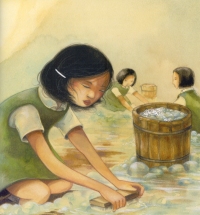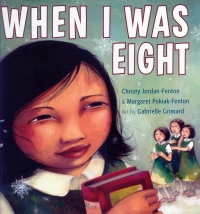| ________________
CM . . .
. Volume XIX Number 41. . . .June 21, 2013
Olemaun wears away at her Inuit father until he relents into sending her to residential school. At school, the nuns take away her clothes, her name, her hair, and her language. All she has left is her copy of Alice in Wonderland . One of the nuns, her teacher, tries to break Olemaun's spirit by humiliating her in front of the rest of the class, giving her extra chores, forcing her to wear red “clown” stockings, and even locking her in the pitch black cellar. Olemaun finds comfort and courage in Alice's story and, with great resiliency and tenacity, learns to read, eventually triumphing over her foe, like Alice triumphs over the evil queen. 
Olemaun is a great character and an excellent example for young readers to follow. Her intense desire to learn to read and the strength she derives from stories and learning to read amplify the reader's appreciation for reading. Olemaun's resiliency under spirit-crushing trials can be a model for us all; just as Olemaun looked to Alice as a model for strength and survival, readers can follow Olemaun’s example – be strong and resilient, survive and thrive. The illustrations by Gabrielle Grimard convey Olemaun's feelings very well. The yearning, fear, sadness, resistance, and joy all draw the reader more fully into the story. Mostly done in watercolours, the illustrations effectively use the juxtaposition of the roundness of Olemaun's face, dress, and home with the straight lines of the school, the blackboard, the cellar steps, and the nun's cross. Even books and the alphabet are rounded, showing their affiliation to Olemaun. The work lays some important groundwork in understanding the damage the residential school system inflicted on Inuit and First Nation people in Canada, both on individual spirits and the destruction of culture and language. Junior and Intermediate students should be encouraged to read the much fuller version of Olemaun's story in the memoir, Fatty Legs. Highly Recommended. Shelbey Krahn, B.A., B.Ed., M.L.I.S., is sustained by stories in Sudbury, ON.
To comment
on this title or this review, send mail to cm@umanitoba.ca.
Copyright © the Manitoba Library Association. Reproduction for personal
use is permitted only if this copyright notice is maintained. Any
other reproduction is prohibited without permission.
NEXT REVIEW |
TABLE OF CONTENTS FOR THIS ISSUE
- June 21, 2013.
AUTHORS |
TITLES |
MEDIA REVIEWS |
PROFILES |
BACK ISSUES |
SEARCH |
CMARCHIVE |
HOME |
